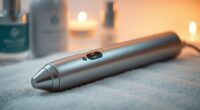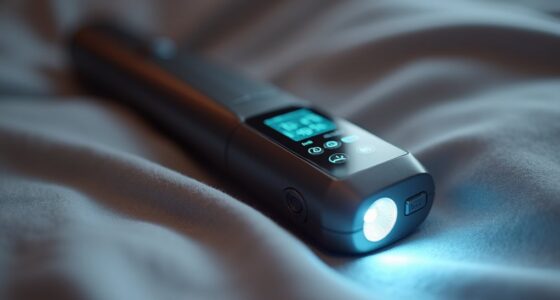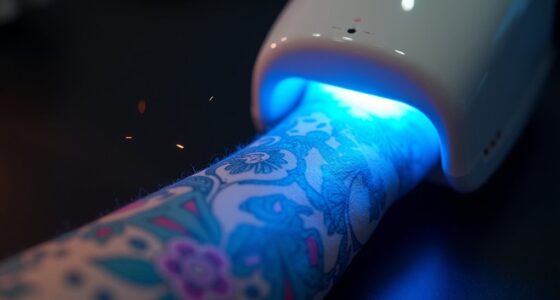To prevent burns during at-home laser treatments, start by knowing your skin type and performing a patch test to check for reactions. Follow the manufacturer’s instructions exactly, including proper device settings and treatment frequency. Prepare your skin by cleansing and avoiding sun exposure beforehand. Use the correct settings based on your skin and keep an eye on your skin’s response during treatment. Learning more can help you safely achieve desired results while minimizing risks.
Key Takeaways
- Perform a patch test and follow manufacturer instructions strictly before each treatment.
- Properly cleanse and prepare your skin, avoiding sun exposure and tanning products beforehand.
- Use device settings suitable for your skin type and calibrate equipment regularly.
- Monitor your skin during treatment for signs of irritation and stop immediately if adverse reactions occur.
- Consult a healthcare professional prior to starting treatments and maintain your device properly.
Understand Your Skin Type and Laser Compatibility
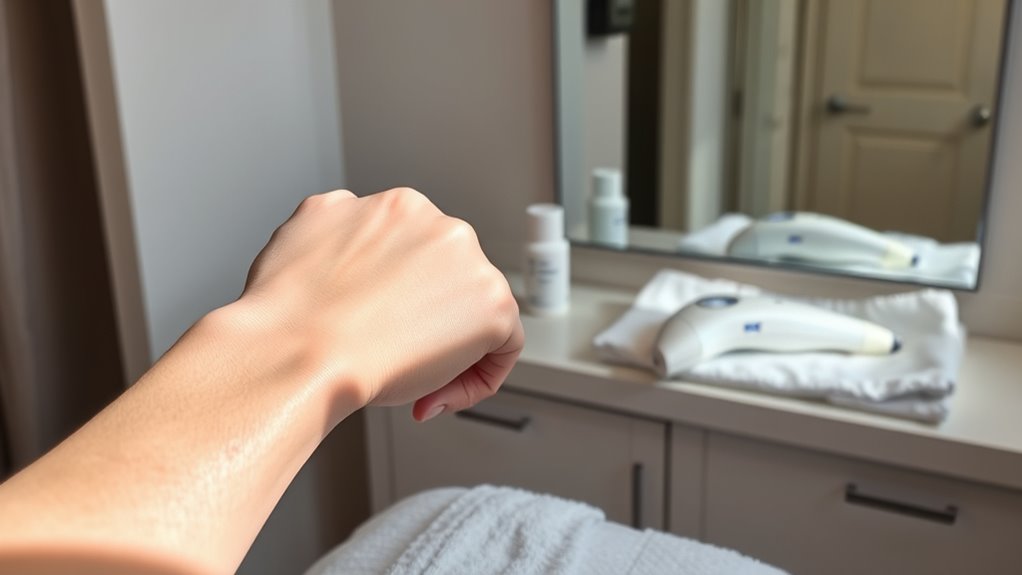
Understanding your skin type is essential before starting at-home laser treatments, as it determines which laser settings are safe and effective. Your skin sensitivity influences how your skin reacts to different laser wavelengths, affecting potential risks like burns or irritation. If you have sensitive skin, you’ll want to choose a laser wavelength that minimizes discomfort and reduces the chance of damage. Knowing whether your skin is fair, medium, or darker helps you select appropriate laser settings and avoid wavelengths that could cause harm. Additionally, using appropriate laser wavelengths based on your skin type can significantly reduce the risk of burns and other adverse effects. Always perform a patch test first to assess your skin’s response. By understanding your skin type and matching it with the correct laser wavelength, you can considerably reduce the risk of burns and achieve better, safer results during your at-home treatments.
Follow Manufacturer Instructions Carefully
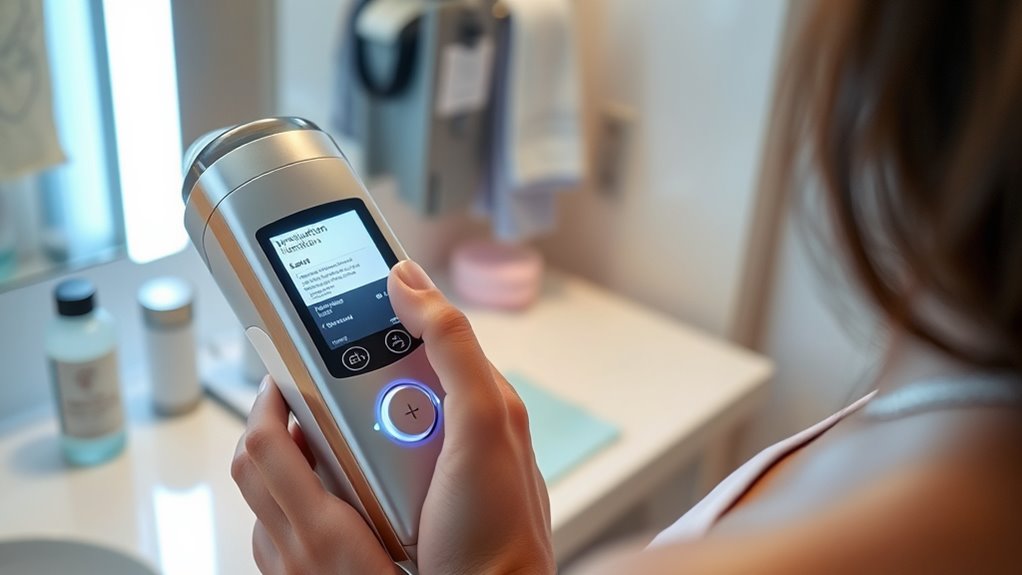
Carefully following the manufacturer’s instructions is essential to guarantee safe and effective at-home laser treatments. Proper adherence guarantees you minimize risks related to laser safety and account for your skin sensitivity. To do this effectively: 1. Read all instructions thoroughly before starting to understand device settings and safety precautions. 2. Use the recommended treatment parameters precisely; deviating can cause burns or skin damage. 3. Follow guidelines on treatment frequency and duration to avoid overexposure, which increases burn risk. Additionally, understanding the importance of color accuracy can help you better assess the results and safety of your treatments.
Perform a Patch Test Before Full Treatment
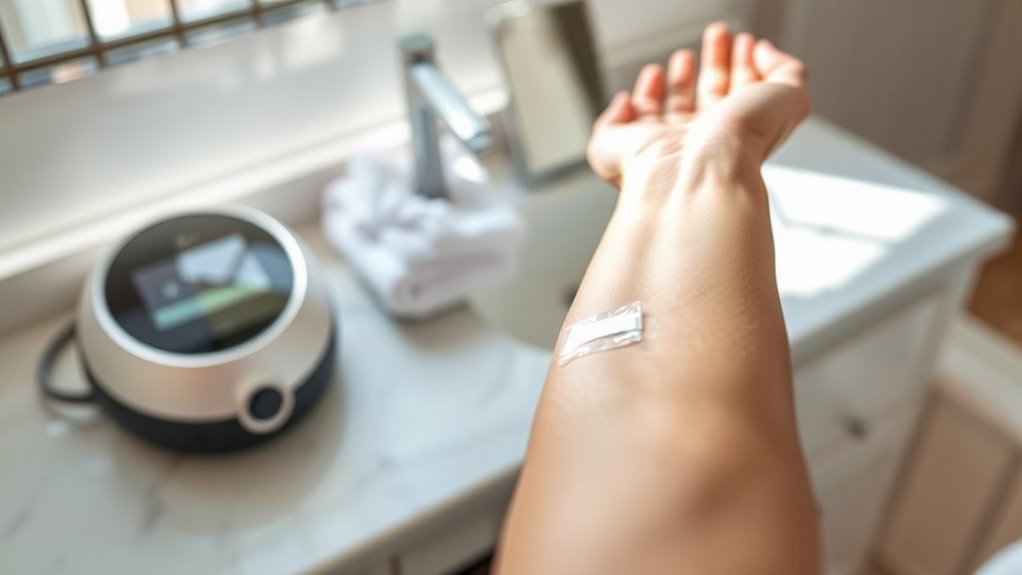
Always perform a patch test before your full laser treatment to verify how your skin reacts. Follow the patch guidelines carefully to make certain you don’t cause irritation or burns. This simple step can save you from potential discomfort and complications later on.
Test Skin Reaction
Before applying laser treatment to a larger area, conducting a patch test to check how your skin reacts is vital. This step helps you identify potential allergic reactions and guarantees safety precautions are met. To perform an effective patch test:
- Apply a small amount of the laser device or gel on a discreet skin area, like behind your ear or on your forearm.
- Cover it with a bandage and wait 24 to 48 hours to observe any adverse reactions, such as redness, swelling, or irritation.
- If no reaction occurs, proceed cautiously with the full treatment, but remain alert for any discomfort.
- Remember that skin sensitivity can vary greatly among individuals, making the patch test an essential safety measure before full application.
This simple test minimizes risks and helps you avoid burns or allergic reactions, guaranteeing your at-home laser sessions are both safe and effective.
Follow Patch Guidelines
Performing a patch test according to the guidelines is essential before moving on to full laser treatment. This step ensures your skin’s compatibility with the product and helps prevent burns. During patch testing, apply a small amount of the laser treatment product to a discreet skin area, following the manufacturer’s instructions. Monitor the area for 24 to 48 hours for any irritation, redness, or adverse reactions. This process helps you confirm product compatibility with your skin type, reducing the risk of burns during the full treatment. Always adhere strictly to patch testing guidelines provided by the manufacturer or your healthcare provider. Skipping this step increases the chance of unexpected reactions, so don’t rush—protect your skin by following proper patch testing procedures.
Prepare Your Skin Properly Before Treatment

To guarantee your skin responds safely to at-home laser treatments, it’s essential to prepare it properly beforehand. Start with a thorough pre treatment cleansing to remove dirt, oil, and makeup, ensuring the laser targets only your skin. Next, perform a patch test on a small area to check for adverse reactions, giving your skin time to react before full treatment. Finally, avoid sun exposure and tanning products for at least a week prior, as these can increase sensitivity. Proper preparation minimizes the risk of burns and irritation. Remember, clean skin helps the laser work effectively, and patch testing confirms your skin’s tolerance. Additionally, staying informed about AI safety developments can help you understand the importance of safe practices in emerging technologies. By following these steps, you set a solid foundation for safe, effective at-home laser sessions.
Use the Correct Settings and Equipment
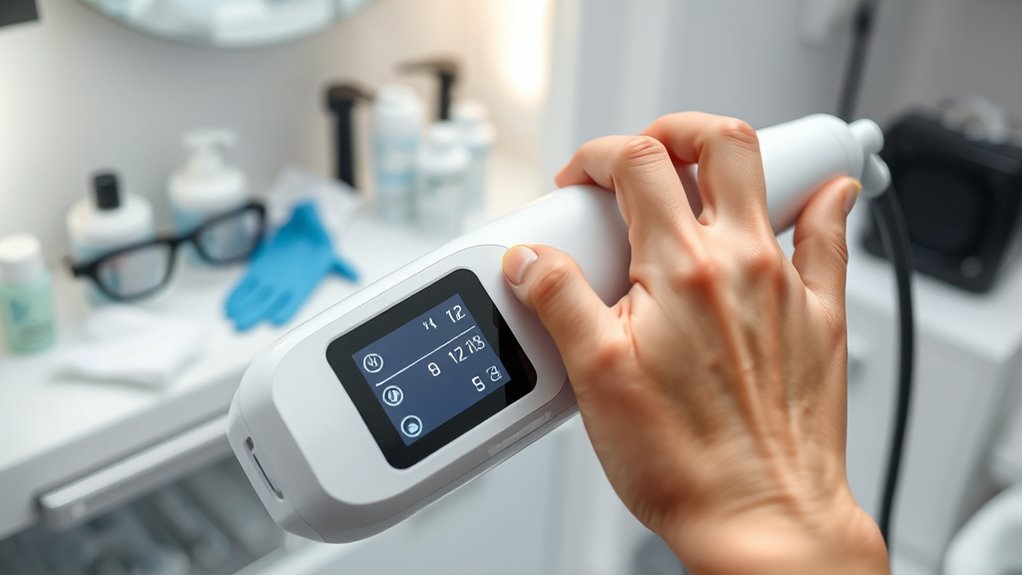
Selecting the right settings and equipment for your at-home laser treatment guarantees safety and effectiveness. Always verify your device is properly calibrated before use, as laser calibration helps deliver the correct energy levels and prevents burns. Read your device’s instructions carefully to choose the appropriate intensity for your skin type and treatment area. Regular equipment maintenance is essential; clean the device as recommended and check for any damage or wear. Using the wrong settings or outdated equipment increases the risk of burns or skin damage. Double-check the device’s display or settings before each session, and avoid making adjustments without guidance. Properly calibrated and maintained equipment ensures consistent performance, making your treatments safer and more effective. Ensuring proper safety precautions are followed further reduces the risk of adverse effects during at-home laser treatments.
Maintain Proper Skin Hydration and Care Post-Treatment

After completing your at-home laser treatment, maintaining proper skin hydration is vital to support healing and prevent irritation. Hydration routines help restore your skin’s natural moisture, strengthening the skin barrier against external aggressors. To optimize this process, consider these steps:
- Use a gentle, hydrating moisturizer to lock in moisture and soothe the skin.
- Apply cool compresses or aloe vera gel to reduce inflammation and refresh your skin.
- Avoid harsh cleansers or alcohol-based products that can compromise your skin barrier.
- Incorporating proper skincare practices, such as gentle cleansing and avoiding irritating ingredients, can further enhance your skin’s recovery.
Prioritizing hydration ensures your skin recovers effectively, minimizes discomfort, and maintains resilience. Proper skin care post-treatment is essential for preventing burns and other adverse effects, allowing your skin to heal smoothly and safely.
Be Aware of Contraindications and Avoid Overuse
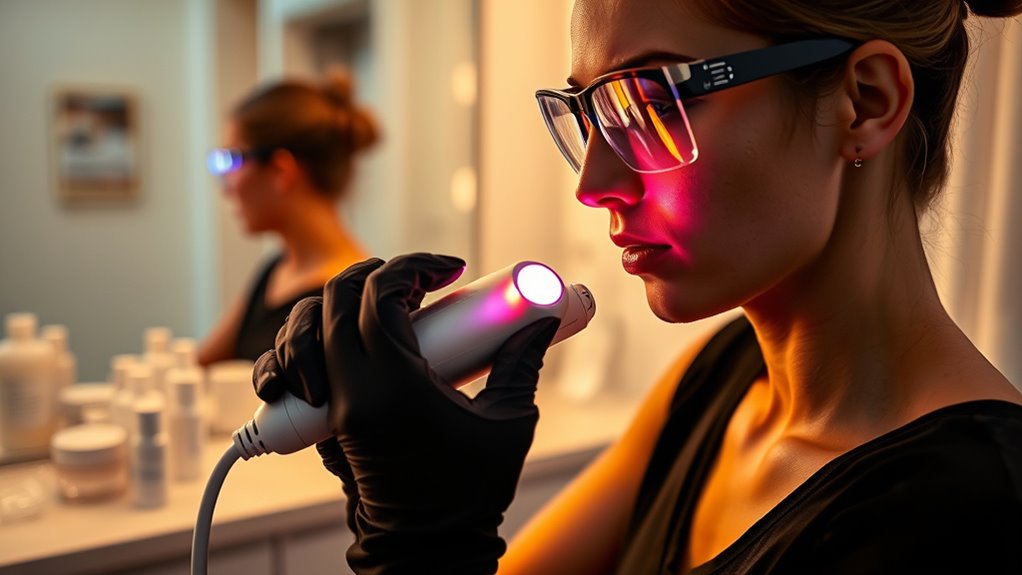
While proper hydration supports healing, it’s equally important to recognize when your skin might be vulnerable. Always consult a medical professional before starting laser treatments to identify contraindications like skin infections, scars, or certain medications. Avoid overuse; sticking to recommended treatment schedules prevents skin damage and reduces burn risk. Regular equipment maintenance ensures your device functions safely and effectively.
| Action | Why It Matters | Key Reminder |
|---|---|---|
| Medical consultation | Identifies contraindications | Never skip professional advice |
| Equipment maintenance | Ensures safety and effectiveness | Regularly check and clean device |
| Follow recommended use | Prevents overuse and burns | Adhere to suggested treatment frequency |
| Monitor skin response | Detects early issues | Stop if irritation occurs |
Frequently Asked Questions
Can I Use Home Laser Devices on Sensitive Skin Areas?
Using home laser devices on sensitive skin areas isn’t recommended without proper precautions. Sensitive skin requires extra laser safety measures to avoid burns or irritation. Always check if your device is suitable for delicate areas, and perform a patch test first. Follow the manufacturer’s instructions carefully, and consider consulting a professional. Prioritizing laser safety helps protect your skin and ensures effective, safe treatments without unnecessary risks.
How Often Should I Perform Laser Treatments Safely?
Picture your skin as a delicate garden that needs careful tending. To keep it healthy, you should space out laser sessions, typically every 4 to 6 weeks. This allows your skin to recover and reduces risk. Stick to safe treatment intervals, and avoid overdoing it. Regular, measured laser session frequency guarantees effective results without damaging your skin, turning your home routine into a safe, glowing success.
Are There Specific Skincare Products to Avoid Before Laser Sessions?
Before your laser sessions, avoid skincare products containing retinoids, acids, or harsh exfoliants, as these can increase sensitivity and risk of burns. Also, steer clear of sunburn prevention products with high SPF or those that cause sun sensitivity. These skincare ingredient restrictions help safeguard your skin and ensure effective treatment. Always read labels carefully and consult your specialist to confirm which products are safe to use beforehand.
What Signs Indicate I Should Stop Laser Treatments Immediately?
When things go south, it’s a red flag you can’t ignore. If you notice increased burn severity or skin discoloration, stop your laser treatment immediately. These signs indicate your skin is reacting badly, and continuing could cause lasting damage. Trust your instincts; your skin’s health is more important than finishing a session. Seek professional advice if unsure, and never push through symptoms of pain or abnormal changes.
How Can I Tell if My Laser Device Is Malfunctioning?
You can tell if your laser device is malfunctioning by paying attention to signs like inconsistent results or unusual noises. Check if the device calibration seems off or if you notice power fluctuations during use, which could indicate a problem. If the device isn’t functioning smoothly or behaves unpredictably, stop using it immediately and consult the manufacturer or a professional to guarantee safety before continuing treatments.
Conclusion
By following these tips, you can considerably reduce the risk of burns during at-home laser treatments. Remember, over 60% of users experience skin irritation when not properly prepared, so taking precautions is essential. Always prioritize your skin’s safety by understanding your skin type, using the right settings, and caring for your skin afterward. Stay informed and cautious—your skin will thank you for it, and you’ll achieve better, safer results.

